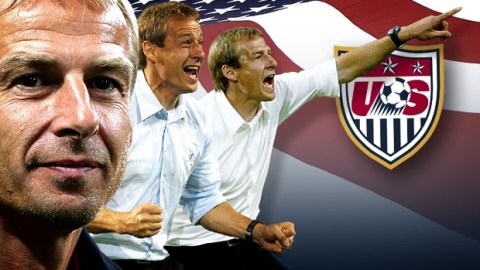Jurgen Klinsmann’s Plan for Transforming U.S. Soccer

All eyes in the soccer world are on the United States this weekend with the Friday announcement that Jurgen Klinsmann will be taking over as head coach of the U.S. Soccer side. There is now much speculation as to how Klinsmann will re-make not just the U.S. men’s senior side but the culture of U.S. soccer itself, transforming the entire system down to the youngest youth national team.
Turns out Klinsmann has already written out the blueprint in an op-ed for the BBC following the demise of the England side in the 2010 World Cup. Offering advice to English footballers, Klinsmann reflected on his experience “regenerating” the German program in the lead up to the 2006 World Cup, aided by trusted assistant Joachim “Jogi” Loew.
Here’s key excerpts from the article:
‘Jogi’ and I began the whole regeneration process by trying to give our national team an identity.
We eventually decided to go down an attack-minded route, passing the ball on the ground from the back to the front line as quickly as possible using dynamic football.

Klinsmann and Loew designed a new blueprint for German football
From that, we created a style of play that this Germany team in South Africa now really lives and breathes. Since 2004, we have reached two World Cup semi-finals and the final of Euro 2008.
Can England recover from their poor showing in South Africa as quickly as Germany did six years ago? Yes, but they cannot just copy the German style and expect that to succeed for them.
Every nation has its own culture and specific environment as well as its own footballing identity. England have to develop their own vision and decide how they should play….
…
When Jogi and I took over the German side, we made our plans very public and made it clear that we were trying to rebuild from the bottom up.
The German Football Association (DFB) helped us by putting a lot of pressure on all the first and second division teams in the Bundesliga to build academy programmes and ensure talented young players were coming through but we still had to decide on our playing style.
To do that, we quizzed everyone we could.
We held workshops with German coaches and players, asking them to write down on flip charts three things: how they wanted to play, how they wanted to be seen to be playing by the rest of the world and how the German public wanted to see us playing.
If we could define all of that, we thought we could lay out how we wanted to work and then, from there, sort out the training and paperwork behind the scenes.
What we ended up with amounted to 10 or 12 bullet points laying out our proposals. We then announced that it was our intention to play a fast-paced game, an attacking game and a proactive game.
That last term was something the Germans did not really like because they did not really understand what proactive meant. We just told them it meant we did not react to what our opponents did, we played the way that was right for us.
Once we had done all that, we created a curriculum for German football and presented it to the Bundesliga and DFB boards.
At that point, I told them I did not have the time to implement the strategy at all levels because I only had two years to prepare for the World Cup, so I asked for Germany’s Under-21 team to adopt it and that was it.
I brought in a former international team-mate of mine, Dieter Eilts, to run the under-21s and said they had to play the same way as the senior team because they would be a feeder for it.
I was always looking long-term but I knew our plans would be measured by our success at the 2006 World Cup.
There was a lot of negative media at the start. Everybody agreed German football had to change after 2004 but nobody actually wanted to adopt our proposals.
For example, we told the Bundesliga teams and coaches that their players needed to be fitter to play the kind of football we wanted to play.
That meant carrying out fitness tests every three months, which did not go down well with some clubs because I was able to prove that some of them were training their players properly and others were not.
I was basically doubted for the two years I was coach – and when we lost 4-1 to Italy in a friendly game three months before the 2006 World Cup, everybody wanted my blood!
We had another game three weeks later against the United States and we won that one 4-1.
That victory saved my job and kept me in charge for the World Cup because the DFB had been ready to make a change. They wanted the conservative approach again, not the revolution.
But I kept on being positive, explaining that this was how I wanted us to play. I did not know if we would master it in time for the 2006 World Cup but we would give it a shot.
We had the players for four solid weeks before the tournament began and were able to get our thoughts across. They agreed to train the way we wanted them to and do extra work. Soon they started to believe in the system.





